Key takeaways:
- Privacy advocacy empowers individuals to understand data protection and the implications of their digital footprints.
- Art effectively conveys complex ideas about privacy, fostering dialogue and personal connection to issues of data security.
- Community engagement through art creates a collective acknowledgment of shared privacy concerns, transforming individual narratives into a powerful message.
- Sharing art can drive social change by prompting critical conversations and connecting people through shared experiences of vulnerability.
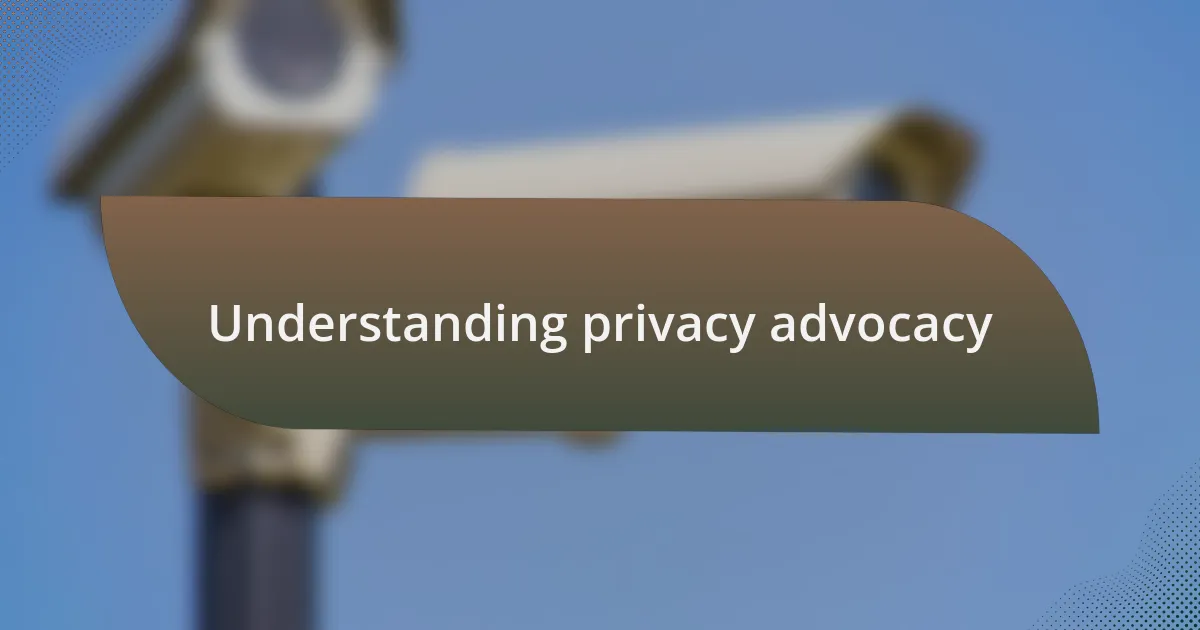
Understanding privacy advocacy
Privacy advocacy is about standing up for our right to control our personal information in an increasingly digital world. I remember a time when I shared a photo online without a second thought, only to see it used in ways I never intended. It made me realize just how important it is to understand the implications of our digital footprints.
At its core, privacy advocacy seeks to empower individuals with knowledge about data protection and security practices. Think about the last time you clicked “I agree” on a long terms and conditions document; did you really understand what you were agreeing to? It’s essential to peel back the layers and explore what these agreements mean for our privacy.
Moreover, privacy advocacy isn’t just a solo effort. Engaging with communities and sharing experiences can amplify our voices. I’ve participated in local workshops where individuals shared their stories about data breaches, and the collective frustration highlighted just how vital it is to advocate for stronger privacy protections. Have you ever felt that sense of solidarity when talking about a shared concern? It underscores the importance of joining forces in this advocacy journey.
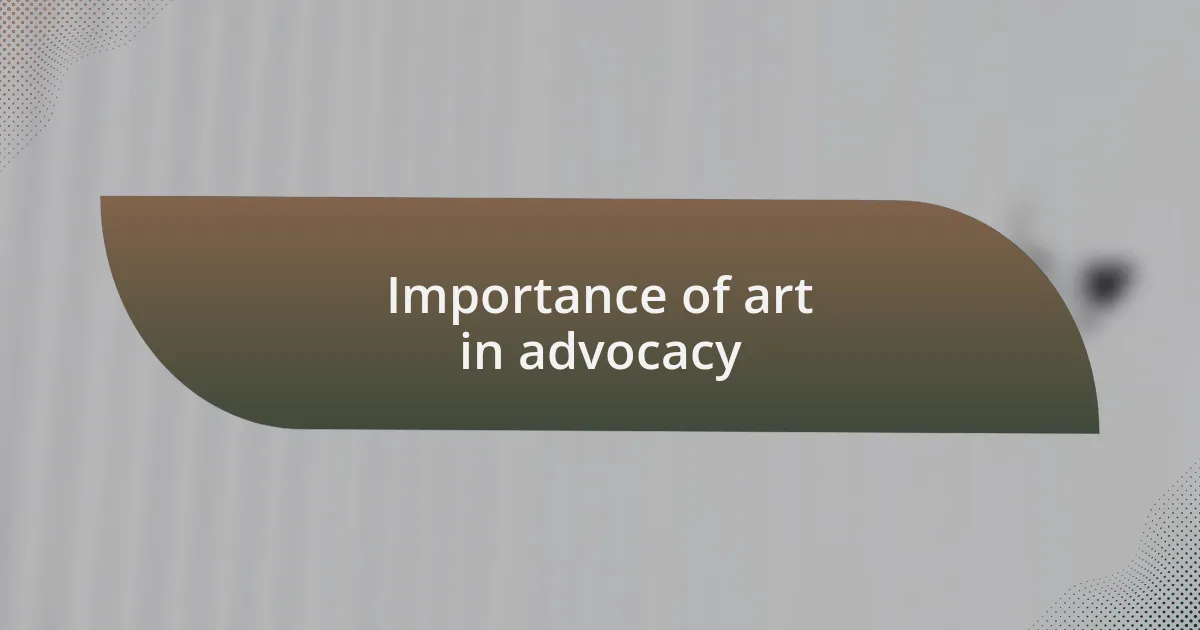
Importance of art in advocacy
Art possesses a unique power to convey complex ideas in a way that is both immediate and emotionally resonant. I vividly recall attending an art installation focused on surveillance technology—it struck me how it captured the invasive nature of data collection in a visual format. This experience transformed my understanding of privacy, reinforcing how art can bridge the gap between abstract concepts and personal experience.
In advocacy, art serves not just as a means of communication but as a catalyst for dialogue. I remember producing a small mural that depicted the evolution of personal privacy through different eras, which sparked conversations within my community. Have you ever found that art moves people in ways words alone simply can’t? It invites viewers to engage, reflect, and often challenge their preconceived notions about privacy and rights.
Furthermore, employing artistic expression can foster empathy by personalizing issues that may otherwise feel distant or impersonal. I once collaborated on a project where we turned personal data stories into a theatrical performance. Witnessing the audience’s emotional reactions helped create a deeper understanding of the nuances in privacy advocacy. Isn’t it powerful when art brings a sense of urgency to critical issues? It transforms the conversation from statistics to real-life implications, pushing us to advocate for change.
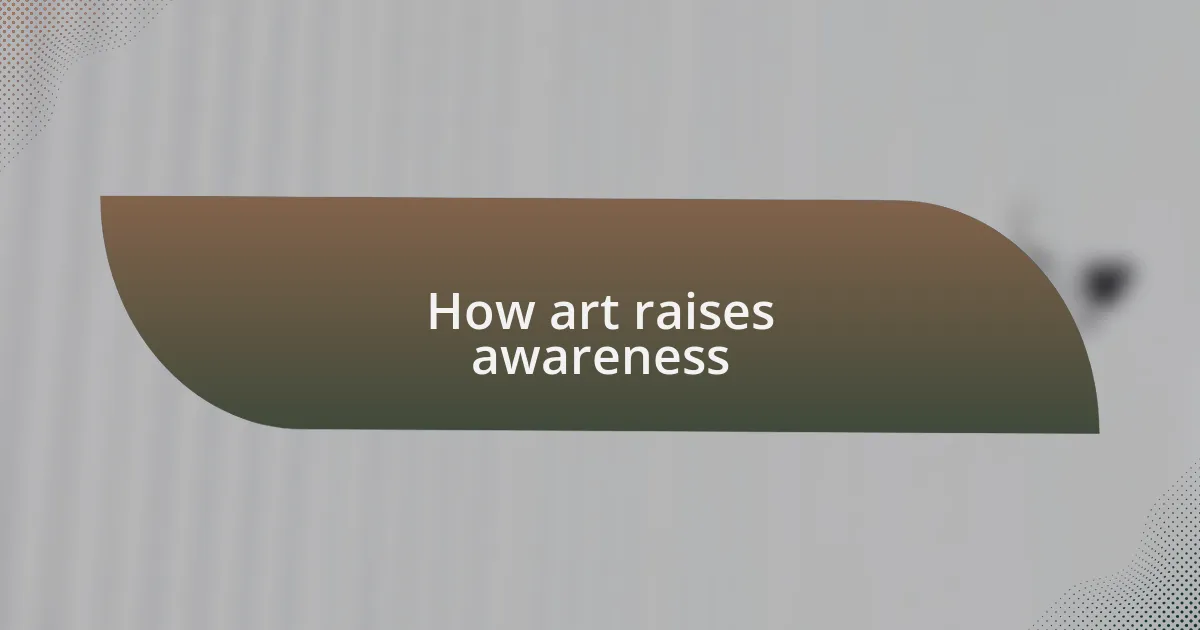
How art raises awareness
Art has an incredible ability to illuminate issues that may otherwise go unnoticed. I remember visiting a photography exhibit that showcased individuals whose lives had been impacted by data breaches. Each image told a story, making the abstract concept of privacy violations feel personal and real. Have you ever looked at a photograph and felt the weight of someone else’s experience? It’s in those moments that awareness truly clicks.
Moreover, art can provoke thought and incite action, serving as a powerful call to arms. I participated in a community art festival where we created interactive installations that invited people to share their thoughts on privacy in a digital age. Engaging with others in this creative space made me realize how often we underestimate the impact of a visual medium. Don’t you find it fascinating how a simple image can ignite conversations that lead to significant change?
This transformation in perception through art is something I deeply cherish. I once joined a collaborative mural project, and each stroke of the brush represented a personal connection to the issue of digital surveillance. Seeing community members contribute their stories to this work not only raised awareness but also fostered a shared sense of responsibility. Isn’t it extraordinary how art can weave our personal narratives into a collective tapestry of advocacy?

Personal journey with privacy themes
My journey into understanding privacy themes began unexpectedly during an artist residency, where I met a fellow artist whose work explored the surveillance state through mixed media. We often discussed how our own digital footprints and privacy choices reflect our identities. Have you ever considered how much of yourself you reveal online? That realization hit me hard, as I recognized my own complicity in the erosion of privacy.
I vividly recall a community workshop where participants shared their stories about feeling exposed in the digital realm. One participant spoke about a data breach that led to identity theft, and I could see the pain in her eyes. It struck me that these stories were not just statistics; they were real experiences that showcased the emotional toll of privacy violations. Doesn’t it make you reflect on how often we overlook these human aspects in discussions about data security?
Through my artistic endeavors, I’ve connected with individuals who view privacy not merely as a right but as an essential part of their dignity. I took part in a digital collage project where we each contributed pieces representing our views on privacy. The powerful combination of our visual expressions and narratives compelled me to think: how can we advocate for privacy in a world that often feels indifferent? Engaging with these ideas has transformed my perspective, instilling a strong sense of urgency to address privacy issues through my art.
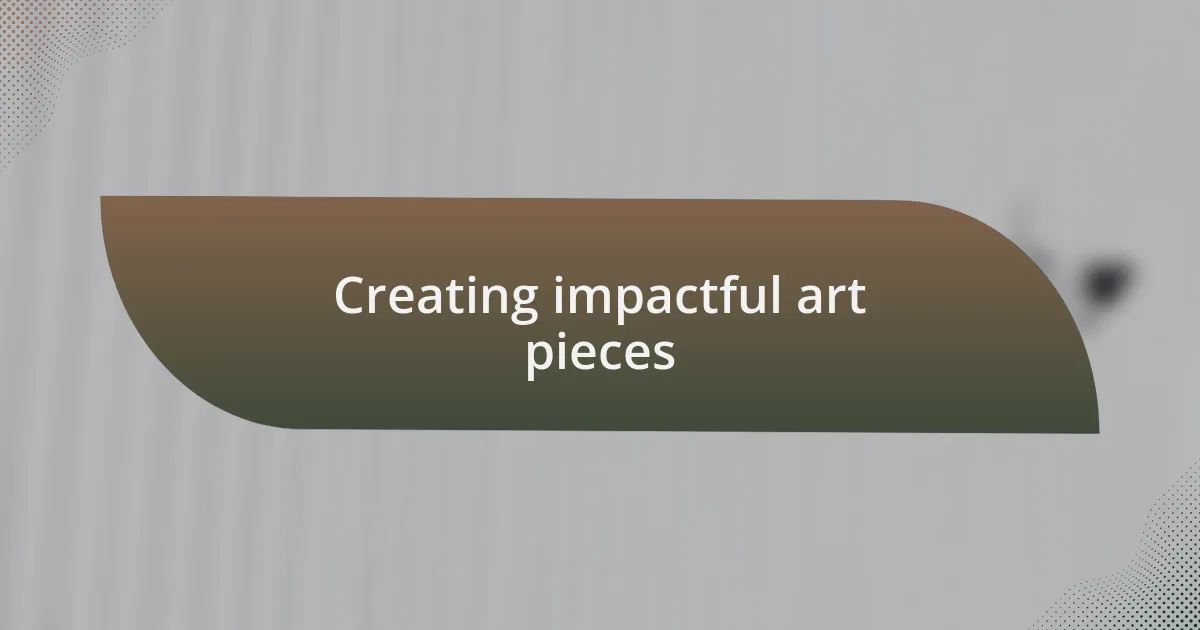
Creating impactful art pieces
Creating art that resonates requires a deep emotional connection to the subject matter. When I first experimented with visual storytelling around privacy issues, I painted a series of portraits that reflected the emotions tied to surveillance—fear, vulnerability, and anger. I remember standing at an exhibition opening, watching people’s reactions as they stared into the faces I had captured. It made me wonder: do they see themselves in these reflections of anxiety?
A memorable piece I created was an installation that combined everyday objects with digital elements, symbolizing our dual existence in both the physical and virtual worlds. As visitors walked through, they encountered a series of screens displaying data streams while surrounded by familiar items like keys and letters. I noticed them pause, some even reached out with reluctant fingers, as if trying to reclaim their sense of ownership. Isn’t it interesting how tangible representations can provoke such introspection about our privacy?
I’ve also found that collaborating with others amplifies the impact of my art. In a project focused on collective healing, participants shared personal anecdotes about their experiences with privacy violations, and I visualized those stories through a mural. Hearing their voices fueled my creativity, and every brushstroke became a testament to their struggles. How can we not get inspired when real-life stories collide with artistic expression, creating a dialogue that sparks awareness?
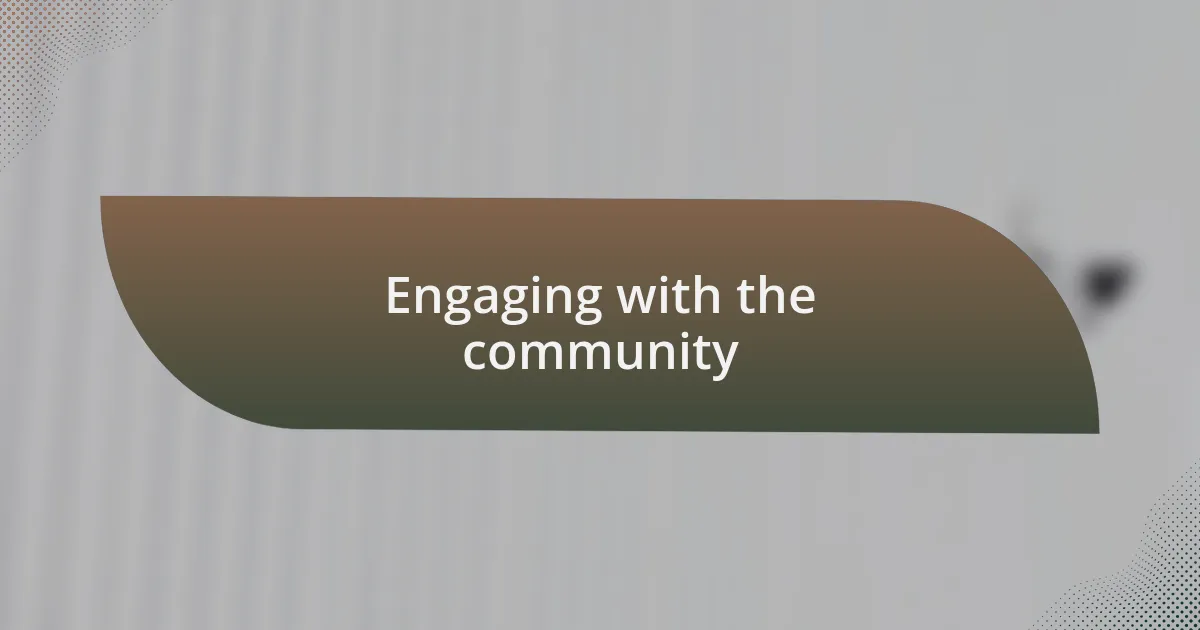
Engaging with the community
Engaging with the community has truly opened my eyes to the power of collective experiences. I vividly recall organizing a workshop where attendees created their own art pieces around the theme of privacy. As they picked up brushes, I could sense a palpable connection growing among us, as each stroke became a shared acknowledgment of our fears and hopes regarding digital security. Isn’t it remarkable how art can unite diverse voices into a singular conversation?
One particularly touching moment occurred when a participant shared a heartbreaking story about how their online information was compromised. Inspired by their vulnerability, I suggested we turn their experience into a communal canvas, allowing everyone to contribute their thoughts and feelings. As we worked together, the mural transformed into a powerful reminder of resilience within a community often fractured by isolation. How can we underestimate the healing power of connecting through creativity?
In another instance, I participated in a local art fair, setting up a booth where I displayed a series of interactive pieces addressing digital privacy. I invited visitors to write their thoughts about privacy on sticky notes, which we then added to the artwork. Watching people scribble their concerns amidst laughter and shared stories emphasized the need for open dialogue about these issues. Have you ever realized that sometimes, just starting a conversation can initiate a profound change?
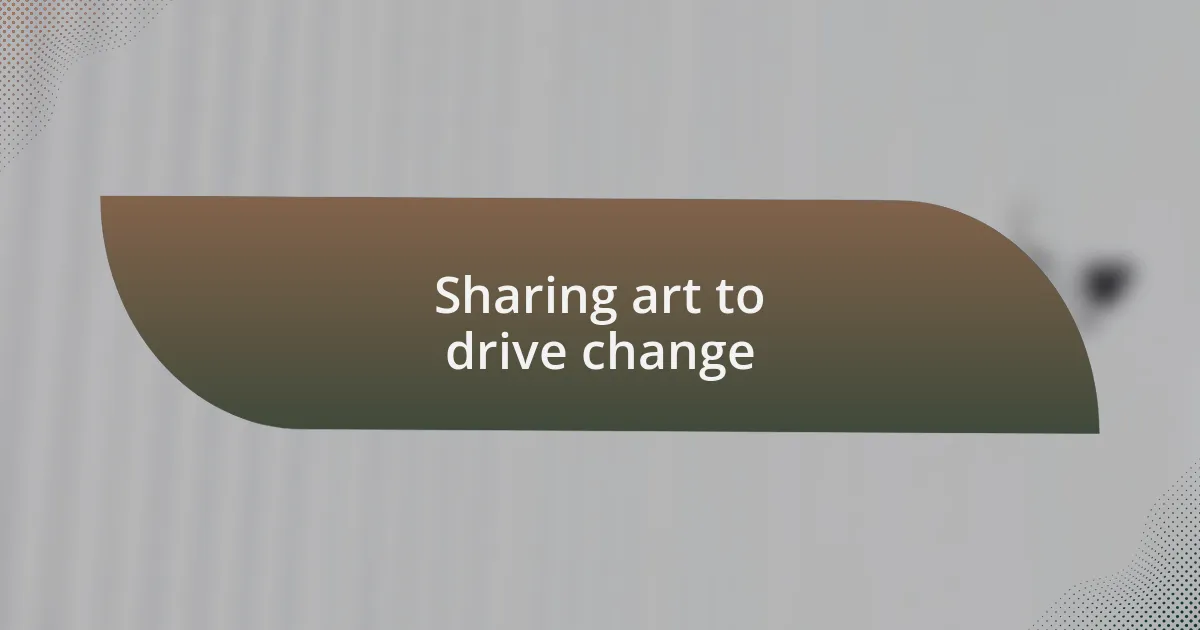
Sharing art to drive change
Sharing art to drive change can take many forms. I once collaborated with a local nonprofit to create a public installation that invited people to reflect on the implications of data collection. As passersby interacted with the piece, I noticed how a simple act of engagement sparked curiosity and dialogue about their own digital footprints. Isn’t it fascinating how art can prompt critical conversations about something often taken for granted?
In another experience, I led a virtual art showcase where participants submitted their interpretations of privacy through various mediums—painting, photography, even poetry. When I displayed their work online, the emotional resonance was palpable. People expressed feelings of vulnerability and empowerment, revealing a deep desire for protection in an increasingly invasive digital world. How often do we consider that art can not only serve as a medium for expression but also as a catalyst for social change?
I’ve also seen powerful transformations occur when art is shared on social media. I once posted a piece representing the fragility of personal data, coupled with a personal narrative about my own experiences. The response was overwhelming; countless individuals shared their stories in the comments, transforming my single artwork into a mosaic of collective experiences. Isn’t it incredible how one piece can ignite a movement and connect us all?